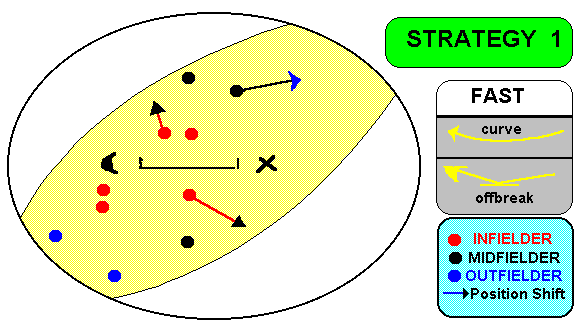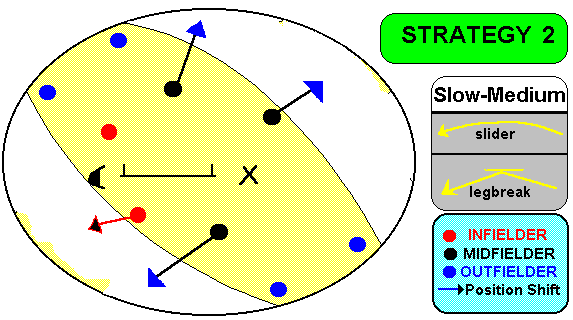




Here is why.
In baseball, it would be okay to have one pitcher throw many kinds of pitches, because batters can hit only into a quadrant ahead of them to score, and fielders can be positioned to cut off most line drives, usually making it necessary to hit over the fielders' heads for any kind of scoring. In cricket, because fielders have to be positioned to cover 360 degrees, specialist pitchers are a big help... because you can estimate where the batter is likely to hit a certain kind of pitch....and place your fielders there!
In other words....when you pick your specialist pitcher, you also pick the kind of pitching that is to be delivered...and you set your field of 9 to cover the possible hits that could be made against it. For example, 100-mph fastballs are unlikely to be hit back past the pitcher....it is difficult to pull sliders around to your left....curve balls, on the other hand, are likely to wind up in the left outfield. You get the idea?
All right, here are a couple of examples of how this might work. In both cases, we assume the batter is right-handed.



Both baseball and cricket consist of a series of one-on-one duels... between a batter, and a pitcher/bowler who is supported by a set of fielders. In both baseball and cricket, the succession of these "duels" IS the game , with final scores representing the cumulative outcome of these "duels".
In baseball, it is the pitcher who is challenged to "duels", by a series of batters. Each duel can last 3 to 10 pitches ---and there are 27 or more such one-on-one duels, between a single pitcher, and nine opposed batters, each of whom gets three or more chances at-bat, or "duels", to score during the course of the game. (The starting pitcher is "relieved" only if he is tired and needs a "relief pitcher" to close out the game...or if he has been scored against too often in the beginning !)
In cricket, it is the batter, not the pitcher, who takes center stage and is challenged by a series of pitchers/bowlers. An individual batter who is doing well could face 20, 50 or over 100 pitches.. 3, 4 or more pitchers/bowlers, could take turns to try to get him out, unlike baseball where batters take turns in challenging a single pitcher! In fact, 5, 6, even 7 pitchers/bowlers are used during one cricket inning.
You understand baseball best by starting with the Pitcher, then looking at the field placement, and finally at how a baseball batter could deal with them. If the Pitcher and Fielders are consistent, there simply won't be any hits....only if a batter can break through, or get the Pitcher and fielders to commit errors, will there be any scoring.
To understand cricket strategy, start with the batter, see all he can do, and then look at Fielding and Pitching/Bowling as ways to limit the batter. If the Pitching/Bowling and Fielding strategies work, batters can be held to low or zero scores; if they do not, the batters can score as much as they like...and win the game.
In a cricket match (game) then, you would expect to see different kinds of batters come up to bat, each being tested with different pitching styles...and fielding formations.
For a complete cricket inning, the batting team can send up 11 batters.
Batters 1 and 2 are called "opening batsmen"....like "lead-off batters" in baseball, they are supposed to be consistent, not necessarily score the big runs. In cricket, if they can stay on base for 30 minutes or more, they have done their job.
Batters 3, 4, and 5 are supposed to be consistent and high-scoring...the best batters in the team are usually in those positions, like "clean-up hitters" in baseball.
Batters 6, 7 and 8 are the "power hitters"....not expected to stay too long on base, but able to score quickly and fast.
Batters 9, 10 and 11 are the "tailenders", i.e. players who are in the team for other things than batting...such as pitching (bowling) or catching (wicket-keeping). They may be able to bat, but are usually not in the team for that reason.
Against this kind of batting line-up, the opposite team's two starting pitchers will typically be their fastball specialists, who can make the shiny new ball move in the air with maximum speed...and, who are also the bowlers/pitchers most likely to get past the steady defenses of the "opening batsmen" (see above). As the ball loses its shine, and grips the ground better, the slower pitchers/bowlers who use "breaks" off the ground as their primary strategy are brought in to pitch...their greater ability to use cutters and breaks is supposed to work better against the more aggressive top and mid-order batters! The fast-ball specialists may be brought back (which is allowed in cricket, though not in baseball) to finish up the tail-end batting.
If the starting pitchers/bowlers succeed in getting the top-order batters out for low scores, the "relief" pitchers/bowlers might use "attacking" field formations to restrict the score even more, and get more batters "out". On the other hand, if the "opening batsmen" have done their job and the top-order batters are in good form, the "relief" pitching/bowling will use more "defensive" fielding to keep down the runs, and perhaps get the batters out by making them over-confident.
A good team will have one or two extra pitchers/bowlers to provide this kind of variety, change of pace or added relief..a team with 5 or 6 pitchers/bowlers is exceptionally strong on the field.
Because so many different kinds of batters and pitchers/bowlers can interact with each other during the course of a cricket game, the interplay between batters and pitchers can shift with every "out", and every dozen runs. This is what keeps cricket interesting, to those who understand its strategy.

Now, suppose we are looking at a 40-over cricket game, where each team is allowed about two hours or 10 outs to complete its batting.
After the coin toss between the opposing captains to decide who bats first, the team batting first has the job of putting on the highest possible score before its two hours are up, or when ten of its batters are out...whichever comes first.
The captain or coach of the first team will set a mental mark...perhaps a half-way mark, like one hour (20 overs) of batting. A typical strategy for the team would be to try to get to this point without too many "outs"... ...no more than 2 or 3...and a decent score, say 50 or 60 runs.
Suppose the score is 60 for 3 outs. The team has another 20 overs (about one hour) left, with 7 outs in hand. With so much batting to come, the team will try to increase its scoring rate from the current 3 runs per over, to 5 or 6 per over....meaning that the batters will take more risks, attempt bigger hits, regardless of "outs"....to end up with a total score of around 160 to 200 runs.
Suppose the first-half score had been lower...say, 40 for 3 outs. The team will have to try even harder...6 or even 7 runs per over....to come up with a respectable total of 160 to 200. Or, suppose the score was 60, but there were 5 "outs"....with the top of the batting order already out, the remaining batters would have to play more defensively, to stay in and add to the total.
Now, suppose the first team has already batted, and scored 170 runs in its forty overs.
As their opponents go in to bat, they know they need to score 171 in their forty overs to win the game.
This amounts to a scoring rate of at least 4.3 runs per over. The second team has to get to its half-way mark with a scoring rate of 3+ runs an over...i.e. better than 60 runs...to have a good chance of winning. So it decides to go for 70 to 80 runs, with no more than 3 outs, by its half-way point.
If it has scored 80, it has only 91 more runs to go, in 20 overs, with 7 outs in hand....a scoring rate of 4.5 runs per over, which is only slightly greater than the pace it has maintained so far ( 4 runs per over). Maintaining the pace should be enough to achieve a victory.
If it has too few runs, it has to bat faster; if there are too many outs, the remaining batters have to be more "defensive" yet maintain the required pace. If the second team succeeds in its run chase, it has won the match.
This is only one example of batting strategy with time limits. Some teams like to reverse the approach....score fast in the first half of their alloted time(over) limit, and "coast" in the second half.
Teams batting second sometimes favor this approach, because it makes the second half of their batting an easier propostion....the early high scoring provides a cushion for batters lower in the order, to relax and score the needed runs.